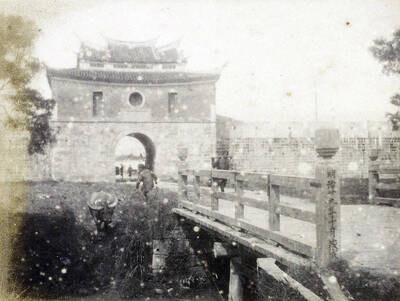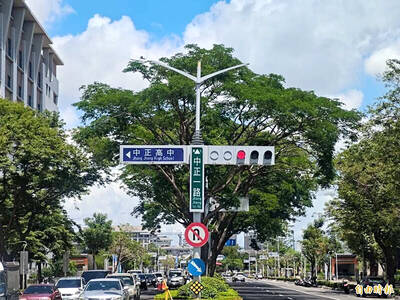Why doesn’t Taiwan have any World Heritage Sites? The answer is fairly clear. The list, currently comprising 878 sites in 145 countries, is compiled by UNESCO, part of the United Nations. And Taiwan, despite all its best efforts, still isn’t a member of the UN.
Even so, China — whose pressure is the main, indeed the only, reason Taiwan isn’t a UN member — hasn’t managed to include any Taiwan sites in its own listings, at least not yet. It has 37 sites of its own in this sumptuous official guide to all the current sites worldwide. The site nearest to Taiwan that the book contains is on the Ryukyu Islands — the “Gusuku Sites and Related Properties” — listed under Japan’s 14 entries.
China routinely gives weather forecasts for Taipei on its domestic TV services, and it would come as no surprise for it one day to succeed in including some Taiwan sites in its UNESCO listings. The procedure for inclusion is that UN member-states submit proposals and these are then vetted by UNESCO committees. But to date no Taiwan sites appear, under any national heading.
This is a huge pity. The criteria for inclusion are deliberately set very wide, with 10 categories. Essentially, though, there are two groupings — cultural or historic significance, and outstanding natural beauty. Taiwan could well get several such places accepted for inclusion.
The Nantou mountain area centering on Yushan (玉山) would easily qualify (China got its own Mount Sanqingshan National Park in Jiangxi Province included as recently as last year). So too would our many historic Aboriginal sites — one of UNESCO’s criteria is places that are “an outstanding example of a traditional human settlement, land-use, or sea-use which is representative of a culture (or cultures), or human interaction with the environment when it has become vulnerable under the impact of irreversible change.”
That having been said, The World’s Heritage remains a wonderful publication, either to read through, browse, or keep for reference. It lists its contents in order of acceptance by UNESCO, and the first was the Galapagos Islands (“a tossed salad of marine species”) in 1978. But the essential motive for such a collection came earlier, in the 1950s, when Egypt’s construction of the Aswan High Dam necessitated the moving of the unique and vast Abu Simbel temple complex, otherwise doomed to be drowned. This was successfully achieved after a worldwide fund-raising scheme, and the concept of numerous other sites all over the globe that needed to be preserved, if rarely so dramatically, was brought to the front of people’s minds.
Today Italy leads the list, with 43 sites. Spain has 40, France 33, Mexico 30, Japan 14, Indonesia seven, Malaysia (surely under-represented) three, and so on. The US has 20, and the UK 27.
Major absences, apart from Taiwan, are hard to catalogue. The English Lake District, though in little need of promotion, and hardly threatened, seems a strange omission. So does anything from Bali. Maybe the Indonesians are considering putting the entire island up for eventual admission.
But there’s no question of this book, comprehensive though it is, being a definitive or in any way a final listing. “Many sites of outstanding universal value have yet to be included in the List,” writes Koichiro Matsuura, Director-General of UNESCO, in his Forward.
This book is enormously stimulating of travel plans. How magnificent the Three Parallel Rivers of China’s Yunnan Protected Areas look, containing 15 such areas (though one wonders what that means in reality) in eight geographical clusters. Of the cities included here, Venice (“an incomparable series of architectural ensembles”) must be preeminent for anyone who’s ever seen it, and for me, Morocco’s Fez (whose Medina was included early on, in 1981) carries powerful memories. The primeval beech forests of the Carpathians (Slovakia and Ukraine) and the Norwegian fjords both look incredibly enticing.
And there’s no reason why Taiwan’s relative modernity — its Aboriginal settlements apart — should in any way exclude its many historic sites from consideration. Australia managed to have Sydney Opera House included in the List in 2007, for instance, hardly historic, and certainly not a natural phenomenon. China, of course, has very many sites of both historic and natural splendor, but Taiwan boasts the highest mountains in East Asia, still relatively unspoiled, as well as many urban sites displaying a fascinating history of migration and cross-cultural settlement.
“Interchange of values” is the first of UNESCO’s criteria for inclusion, and it was under this head that China got the historic center of Macau included in 2005. Under this head, Tainan would be ripe for inclusion, and even the small historic area of Hsinchu — the main point of entry for Chinese immigrants for centuries — might not be exempt from consideration.
All in all, this is a marvelous book, a fact that’s hardly surprising considering the riches it catalogues. It’s easy to use, with the sites listed in order of admission to the World Heritage List, but with detailed lists for each country, plus continent maps on which all the sites are located.
In short, from now on I couldn’t conceive of embarking on any foreign excursion, however brief, without consulting this book’s voluminous but colorful pages (there are more than 650 photos) as part of my travel preparations. But I’m fortunate in not needing any introduction to Taiwan’s own marvels. Other travelers, though, won’t be so lucky.

June 9 to June 15 A photo of two men riding trendy high-wheel Penny-Farthing bicycles past a Qing Dynasty gate aptly captures the essence of Taipei in 1897 — a newly colonized city on the cusp of great change. The Japanese began making significant modifications to the cityscape in 1899, tearing down Qing-era structures, widening boulevards and installing Western-style infrastructure and buildings. The photographer, Minosuke Imamura, only spent a year in Taiwan as a cartographer for the governor-general’s office, but he left behind a treasure trove of 130 images showing life at the onset of Japanese rule, spanning July 1897 to

One of the most important gripes that Taiwanese have about the Democratic Progressive Party (DPP) is that it has failed to deliver concretely on higher wages, housing prices and other bread-and-butter issues. The parallel complaint is that the DPP cares only about glamor issues, such as removing markers of Chinese Nationalist Party (KMT) colonialism by renaming them, or what the KMT codes as “de-Sinification.” Once again, as a critical election looms, the DPP is presenting evidence for that charge. The KMT was quick to jump on the recent proposal of the Ministry of the Interior (MOI) to rename roads that symbolize

On the evening of June 1, Control Yuan Secretary-General Lee Chun-yi (李俊俋) apologized and resigned in disgrace. His crime was instructing his driver to use a Control Yuan vehicle to transport his dog to a pet grooming salon. The Control Yuan is the government branch that investigates, audits and impeaches government officials for, among other things, misuse of government funds, so his misuse of a government vehicle was highly inappropriate. If this story were told to anyone living in the golden era of swaggering gangsters, flashy nouveau riche businessmen, and corrupt “black gold” politics of the 1980s and 1990s, they would have laughed.

In an interview posted online by United Daily News (UDN) on May 26, current Chinese Nationalist Party (KMT) Chairman Eric Chu (朱立倫) was asked about Taichung Mayor Lu Shiow-yen (盧秀燕) replacing him as party chair. Though not yet officially running, by the customs of Taiwan politics, Lu has been signalling she is both running for party chair and to be the party’s 2028 presidential candidate. She told an international media outlet that she was considering a run. She also gave a speech in Keelung on national priorities and foreign affairs. For details, see the May 23 edition of this column,